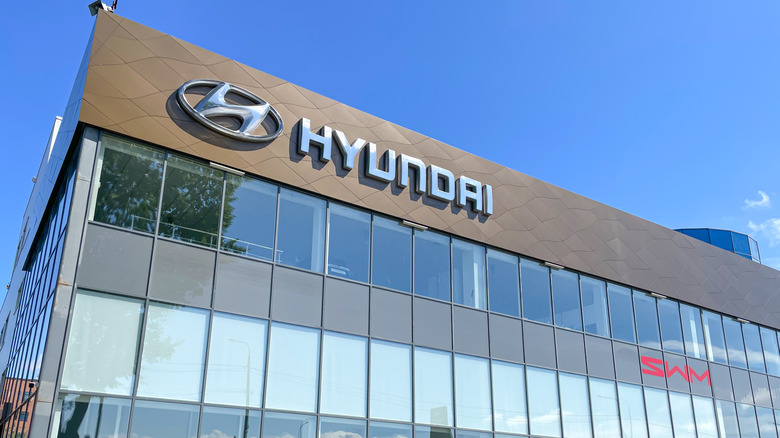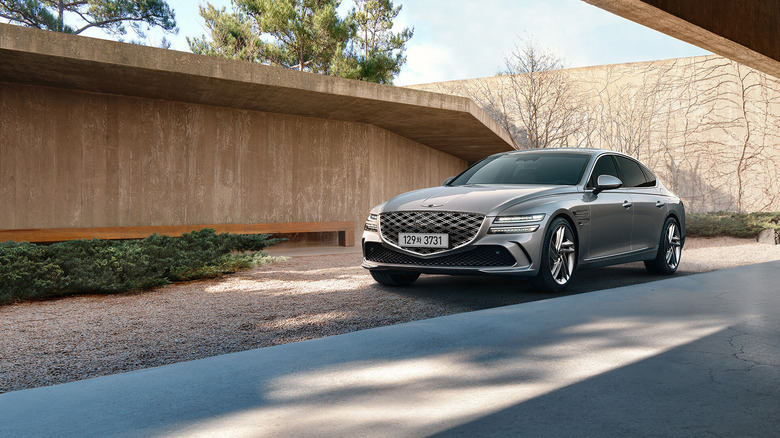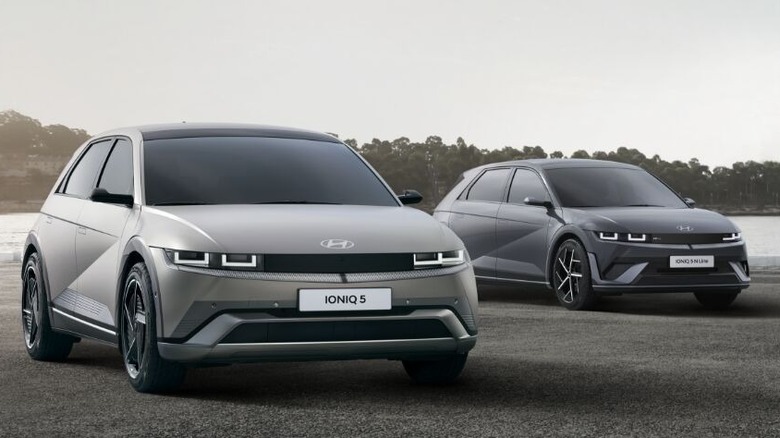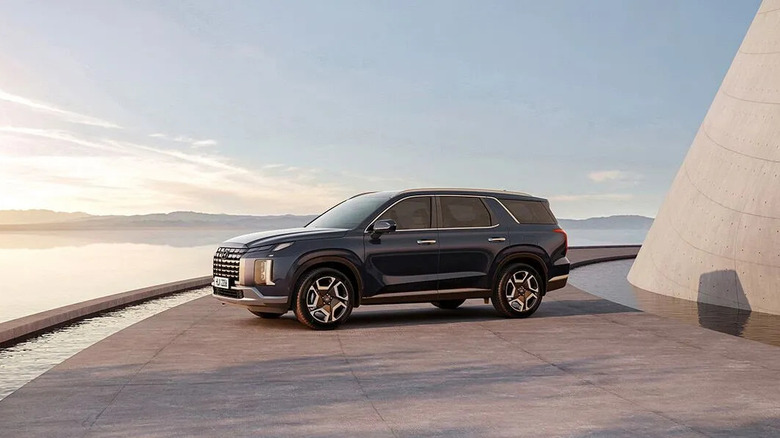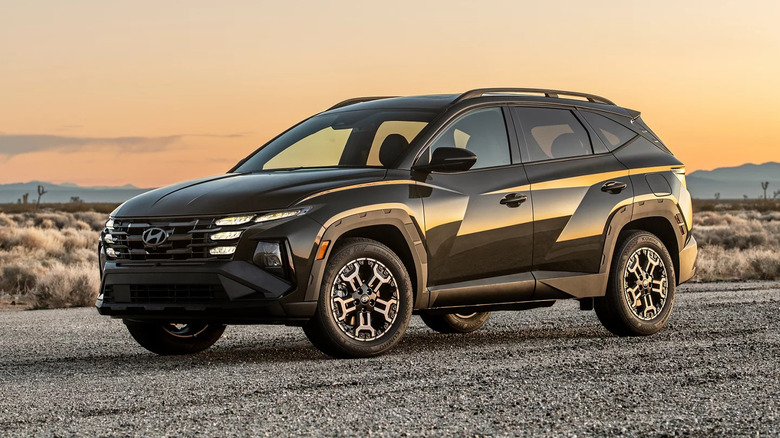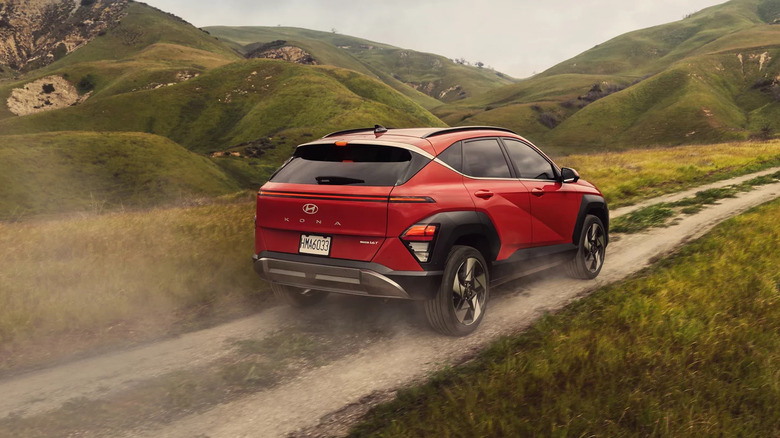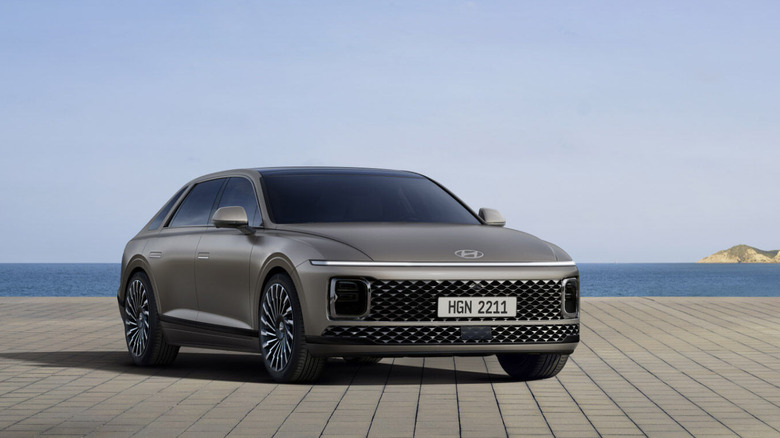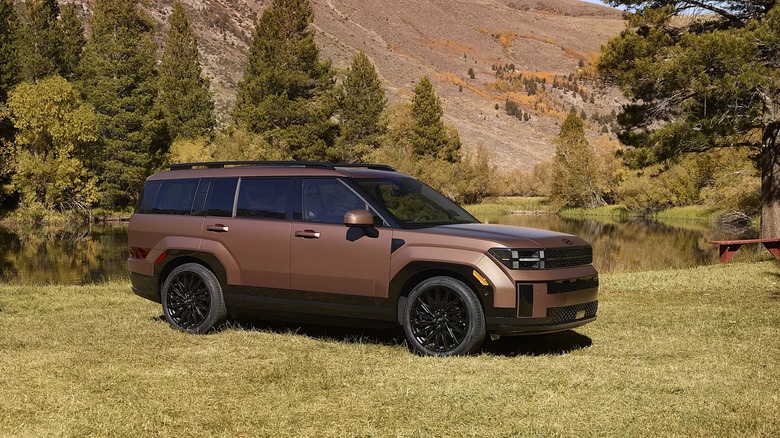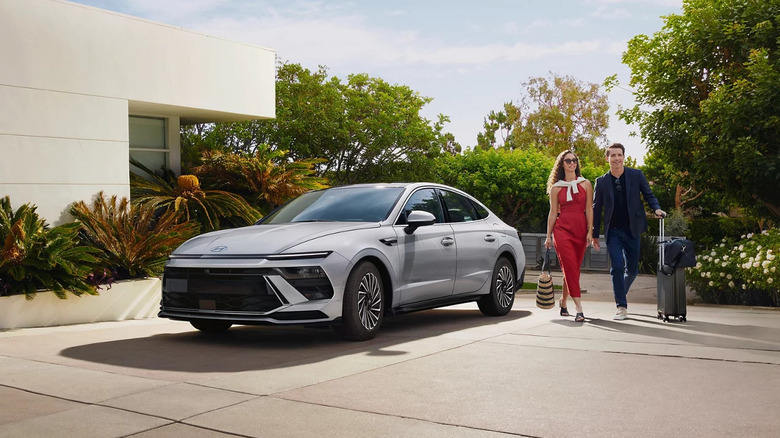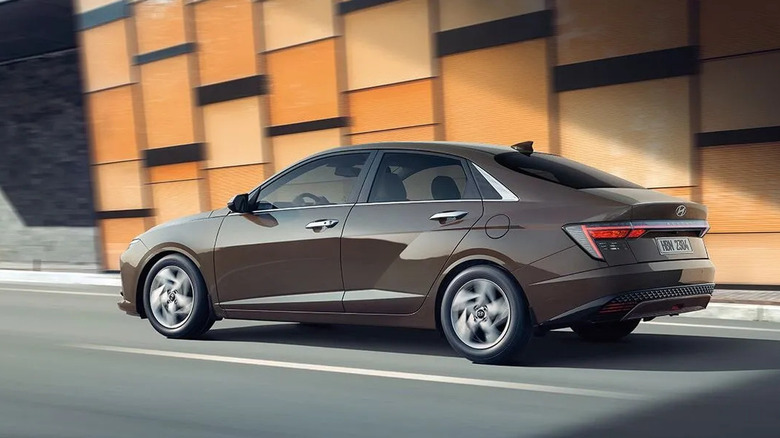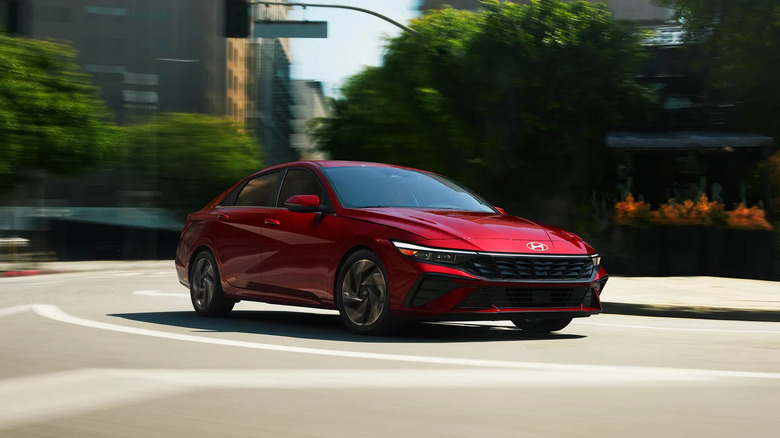10 Of The Most Successful Models In Hyundai History
When someone says "Hyundai," the most likely picture that will probably come to mind will be that of a passenger vehicle — but did you know that the Hyundai Corporation also ships offshore oil rigs, commercial vehicles, trucks, buses, and an assortment of other things? Here, we're talking specifically about Hyundai vehicles, and their division that makes consumer vehicles, which has creatively been named "Hyundai Motors". It, alongside Hyundai's luxury car division, Genesis, is among the world's top automakers and has been for a very long time.
In 2024, Hyundai Motors was ranked third in the world in terms of global car sales, having netted north of 6.82 million units sold, which gave the group a 4.3% market share of the global car market, tying it with Ford and putting it just behind Honda at a 4.5% share. To put in perspective how solid that number is, one in every 23 cars that is sold across the world is from the Hyundai group. To their credit, the Korean automotive giant offers an extremely wide catalog of models, including some new and innovative ones, as well as legacy nameplates that have been around for decades. Of these models, many sell like pancakes, breaking national and international records, and that's what we're here to show you.
These are 10 of the most successful models in Hyundai history.
G80 - 496,843
For a top-of-the-line luxury sedan, the Genesis G80 sold like pancakes from the day it was first introduced in 2016, having reached 250,000 sales by 2021. By the time 2023 rolled around, the G80 had already sold about 390,738 units, and as of April 2025, the total sales stood at 496,843 units. For a vehicle that has a base MSRP of $57,100, these numbers are very impressive, and that's not considering that the sport trims cost even more. Today, all trims on the G80 get great features as standard, including AWD, microlens array (MLA) headlamps, lane keep assist, collision avoidance, a rearview camera, rear cross-traffic monitoring, power-folding mirrors, heated seats at the front and back, and a 27-inch touchscreen infotainment display-cum-gauge cluster.
The three lower trims, called the 2.5T, 2.5T Advanced, and the 2.5T Sport Prestige all get a 2.5-liter inline-four engine equipped with a turbocharger making 300 hp and 311 lb-ft of torque. The topmost two trims, called the 3.5T Sport Advanced and 3.5T Sport Prestige get a much more powerful 3.5-liter twin-turbocharged V6 engine that makes 375 hp and 391 lb-ft of torque — though you will pay a hefty premium. The 3.5T Sport Advanced starts at $69,600, and the 3.5T Sport Prestige costs $77,000. The G80 is a very nice car, but is it $60,000 to $70,000 nice? About half a million people think so.
Ioniq - 514,588
The next car on our list, or rather, range of cars, is the IONIQ series, which is a relatively new EV line of cars that was relaunched by Hyundai in 2021. Since it debuted, Hyundai Motors has sold 514,588 IONIQ vehicles as of April 2025, and projected demand remains strong. From when it was launched, the IONIQ series doubled its sales figures in just two years — reaching 169,812 sales in 2023, up from 65,906 in the launch year of 2021. Currently, the IONIQ series has three main models, which are the $42,600 crossover IONIQ 5, $37,850 executive sedan IONIQ 6, and $58,955 three-row IONIQ 9 SUV, respectively.
There is also a $66,200 performance version of the 5, called the IONIQ 5 N, but for sales figures, we've clubbed both together. All three models get around 320 miles of range, with the IONIQ 6 actually getting the best EPA estimate at 342 miles. Contrary to common sense, the bulky three-row IONIQ 9 gets a better mileage estimate than the smaller IONIQ 5, at 335 miles versus the IONIQ 5s 318. Another distinction we should point out is that the IONIQ 9 makes about 315 kilowatts of power, which is less power than the IONIQ 5, which makes 320 kilowatts. We're not sure about the value in this, but clearly, people are buying them, earning the IONIQ range 10th place on our list.
Palisade - 966,681
The Hyundai Palisade was Hyundai's first attempt at getting a foothold in the luxury SUV market, and was unveiled at the Los Angeles Motor Show in 2018, with sales beginning the same year. In the seven or so years since it was launched, the Hyundai Palisade has actually managed to rack up almost a million units in sales — 966,681 as of April 2025 — and with the way things are going, the model will probably be at a million before the year is out. You can have a new 2025 Hyundai Palisade for less than the IONIQ 5 from earlier, as the base MSRP for the three-row SUV starts at $37,200, which is not a bad starting point for something in this segment.
The main competitor to the Palisade actually comes from Hyundai's sister company, in the form of the slightly cheaper $36,390 Kia Telluride — with both sharing their platforms and powertrains. Stateside, there are seven different trims for the 2025 Palisade, from the entry SE to the all-boxes-checked Calligraphy Night edition. For your nearly $40,000 however, you get a packed feature set: 22 MPG combined, a 3.8-liter workhorse V6 engine making 291 horsepower, eight-passenger seating, onboard Wi-Fi, 5,000-pound towing capacity, a 12.3-inch touchscreen, and a full suite of safety features. Interestingly, two-thirds of the total sales of all Hyundai Palisades come from the United States alone, with the model having sold 506,000th unit in the U.S. earlier this year.
Tucson - 1,600,000+
The Hyundai Tucson is an SUV introduced way back in 2004, and has been quite a popular model ever since, receiving three major updates in 2010, 2016, and 2021 respectively . It achieved a million sales in 2020, in the middle of COVID-19, and between 2021 and April 2025 has sold a further 609,712 units, bringing the grand total up to roughly 1.61 million Tucsons sold. Fun fact: the 15 millionth Hyundai vehicle sold in the U.S. happened to be a Tucson sold in New York. It is still going strong in the U.S., having posted 62,956 sales so far in 2025, and we're not even halfway through the year yet — and it's easy to see why.
It is spacious for its size, handles well, has a reliable powertrain, and most importantly, has a base MSRP of $28,705. You get FWD as standard on the entry-level SE trim that gets a combined economy of 28 mpg, and a paid upgrade to AWD is offered even on this entry trim, though your economy takes a hit, going down to 26 mpg, which is still respectable for an SUV. Standard features on the base-model 2025 Tucson include a spare tire, solar control front glass, six-way adjustable driver's seat, a 12.3-inch touchscreen infotainment system, and wireless Apple CarPlay and Android auto — a fantastic set of features for a car that can be paid off with about $2,300 a month with zero down.
Kona - 2,090,076
The Hyundai Kona is one of the newest additions to the lineup, debuting as recently as 2017 — and since Hyundai makes sales figures from 2016 onwards public, we have the exact number of Hyundai Kona's sold — 2,090,076 units as of April 2025. The Kona is a small-size SUV that currently has a starting MSRP of $24,550 for the entry SE trim, going all the way up to $32,100 for the premium Limited trim, and the N-line variants are also among the fastest Hyundai cars ever made. However, the SE trim gets you plenty bang for your buck, coming with a 2.0-liter Atkinson four-cylinder unit that churns out 147 horsepower and 132 lb-ft of torque, while getting a combined estimated economy of 31 mpg on FWD models, and 28 on AWD ones.
Trims that start with an "S" all have a CVT, while the other three trims, namely the N-line, N-line S, and Limited get an eight-speed automatic gearbox. A six-way adjustable driver's seat is standard, along with the trusty 12.3-inch infotainment touchscreen, wireless Apple CarPlay, Android Auto, cruise control, a rearview monitor, blind-spot alerts, rear cross-traffic assist, and other features usually reserved for more expensive trims. All in all, the Kona has always been a great value offering for those who want an SUV while spending car money — and it remains that way in 2025.
Grandeur - 2,250,000+
The Hyundai Grandeur is another success story from Hyundai. It is actually South Korea's best-selling car at the moment, accounting for one in every three cars sold in the semi-full size segment. It was marketed in the North American Market as the Hyundai Azera and is one of the oldest-running Hyundai models and nameplates, having been introduced way back in 1986. It reminds one a lot of the Toyota Century: both were executive sedans that offered the best-in-house luxuries. In terms of total units sold, the Grandeur model lines have sold more than 2,250,000 units as of last month.
This figure comes from Korean news articles from 2021, and Hyundai official sales figures for the Grandeur from 2022 to present day — totaling these figures up gives us about 2,250,000 unit sales from inception. Now, Hyundai has recently announced the latest seventh-generation Hyundai Grandeur/Azera in Korea, though, there's no indication that the Azera is coming to the USA. Engine choices for Korean customers, however, are stellar, with buyers being able to choose between a 1.6 or 2.5-liter four-cylinder unit or a 3.5-liter V6 that has been around for ages, and you can get either a gasoline or liquid natural gas-powered car as of now. When you convert the currency, the most expensive version of this luxury car is — hold your breath — $38,442. No wonder it's being hidden from the U.S. market — it would demolish the midrange segment.
Santa Fe - 2,393,000+
Announced at the turn of the century in 1999 at the Detroit Motor Show, the Hyundai Santa Fe has been a much-loved but underrated SUV for more than 25 years and is also among the best-looking Hyundai's models ever made. When it launched, it was named after the southwestern capital city of Santa Fe, and debuted with a bronze and terra cotta paint option and a sand-beige interior. The Santa Fe managed to hit the magic number of a million units sold in its 13th year of production, which, coincidentally, was 2013. In 2014, it sold 107,906 units, 118,134 in 2015, and 1,167,950 units between 2016 and April 2025, bringing the grand (estimated) total to a little under 2.4 million global units sold.
To be fair, the Palisade is also making headwind, already having reached a third of the Santa Fe's sales in just seven years. Now, the 2025 Hyundai Santa Fe starts at $34,300 and is available in no less than eight different trims, of which three — the SEL, Limited, and Calligraphy — are available as hybrid powertrains, with the others being gasoline-powered. On the base model SL trims, you get FWD as standard, and AWD is an optional upgrade, with power coming from a 2.5-liter inline four-cylinder engine that makes 277 horsepower and 311 lb-ft of torque. You also get wireless Apple CarPlay and Android Auto alongside other features as standard, which is nice to have for the price.
Hyundai Sonata - 9,170,000+
Another massive success is the Sonata, an affordable sedan for the masses that first went on sale in 1985 and would go on to win the North American Car of the Year award in 2011. From the day it was introduced, many news outlets have reported more than nine million units in sales, though the sales numbers for the Sonata are taking a dip, dropping to a little more than 100,000 in 2024 across both domestic and export markets combined. Still, this makes the Sonata the third-best-selling Hyundai of all time. To be clear, 100,000 unit sales is still very respectable for any car, but it's nowhere near the glory days of 2018 when Hyundai sold 148,494 Sonatas.
Add to that the fact that the Sonata has always been a consumer-friendly car — for instance, it was the first midsize sedan way back in 2005 that came with electronic stability control (ESC) that later became mandatory via an NHTSA directive in 2012. As of now, the Sonata is still on sale in the U.S., and comes with a base MSRP of $26,900, which is not a bad value at all. For the price, buyers get an entry-level SE trim Sonata that comes with a 191 hp, 2.5-liter, four-cylinder engine that only has FWD and gets 32 MPG combined. Blind spot warning and a 12.3-inch touchscreen are standard on all trims, but to get AWD, you need to opt for the $28,000 SEL trim or higher.
Accent - 10,000,000+
If there's one car on this list that's been an affordable, reliable, easy-to-maintain daily driver for the masses, it's the Hyundai Accent. It was, at one point, the most popular Hyundai export car, having hit 2.1 million sales in 2004, and a whopping 10.10 million units sold way back in 2022. That said, the model has been around since 1995, and all in all, the Accent went through five generations, with the last generation running from 2017 to 2022, when it was discontinued for good. It can be argued that the later generation models of the Accent, produced after 2020, are still fantastic value for money — a good example can be had for around $10,000.
For that price you get everything one would want from a budget-friendly sedan: a moderately high trim, good EPA estimated mileage of 36 mpg, a comfortable ride, and a reliable 1.6-liter four-cylinder engine that makes 120 horsepower and 113 lb-ft of torque, for which parts are easily available. As an added bonus, the insurance rates for this generation of Hyundai Accents are also quite affordable, with premiums starting from about $1,600 annually. Please note that this figure is from State Farm for the 2020 model year, customized for Texas — insurance rates vary by state. While it's a shame that the Accent has been discontinued, Hyundai does still offer two sedans in the U.S.: the Elantra (Avante) and the Sonata.
Elantra / Avante - 14,000,000+
Now we come to the best-selling Hyundai — the Elantra, marketed as the Hyundai Avante in some markets but not for all model years though. In 2021, Hyundai reported that the Elantra sold approximately 14 million units globally since it was introduced back in 1990, and since then, has tacked on an additional 895,787 units sold, bringing the total up to approximately 15 million units sold. The Elantra remains the oldest car on our list and also one of the cheapest, with the entry-level SE trim for the 2025 model year coming in at $22,125.
There's really not much to be said about the Elantra really — it's robust, parts and experienced labor is easily available, the engine won't trouble you as long as you keep on top of basic maintenance, and as a bonus, it's started to look really good in recent years.
Hyundai had been in the news recently for having added the same man who designed the Lamborghini Murcielago in 2002 to their design team — a move that has clearly paid off. Power for the 2025 Hyundai Elantra comes from a 2.0-liter inline-four engine that pushes out 147 horsepower and 132 lb-ft of torque, paired to a continuously variable transmission (CVT), which could be a deal-breaker for many, given the dubious reliability of CVTs. On the plus side, solar glass, Apple CarPlay, Android Auto, dual USB type-C ports, keyless entry, and an eight-inch touchscreen infotainment system are standard across the board.
